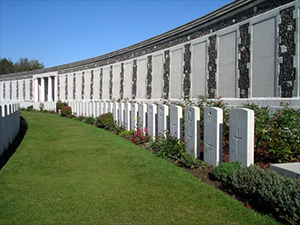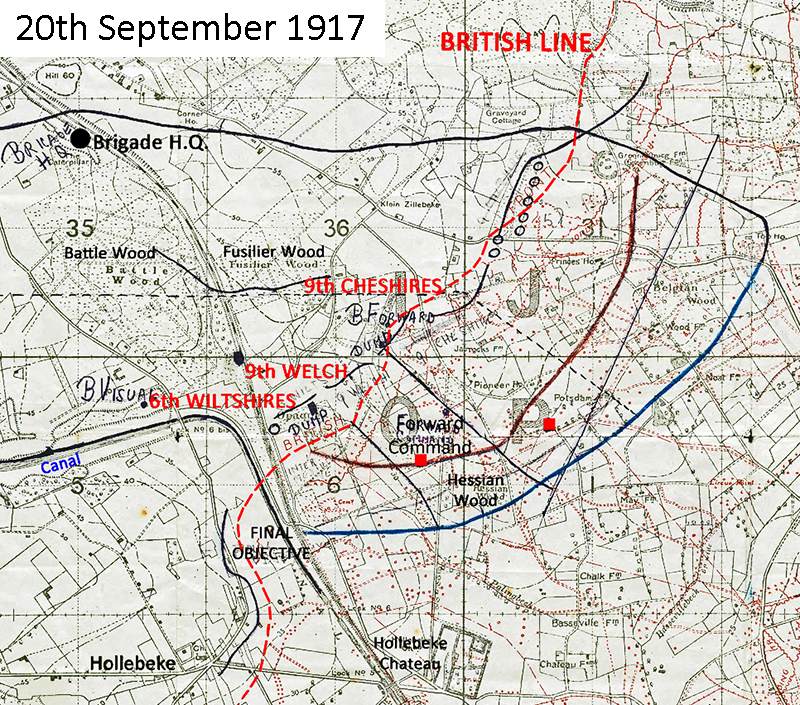First World War Project
Percy Albert WILDISH (of Teynham)
b. 5th May 1895 Private, Service Number 57170 |

Percy Albert Wildish was the youngest of five children to William and Sarah Beatrice (née Smith) Wildish. Percy had three older sisters Laura Isabel (married Thomas John Parrish), Emily Evangeline (married Walter James Revell), and Rose; his only (older) brother was Charles W (married Harriett Roalf).
The family had long-standing local connections. His father, William, and grandfather, John, were both born in Lynsted. William lived his early life in New House Farm (the one in Nouds Lane, which has long-since burnt down to the ground) and at Dully House, Tonge. He later raised his family at Homestall Farm Cottages (Faversham), Lower Newlands (between Lewson Street and Deerton Street), Luddenham and, in 1911, as a farm labourer living in Greenstreet (Teynham side).
In 1911, Percy was 15 years old farm labourer; the same occupation as his father. His war record gives us a picture of Percy as 5 feet, 3 inches tall and a 35" chest measurement. He weighed only 8 stone (112lb) but was described as of "good" physical development.
When Percy joined the Colours in 1915, his parents were living at Royal Cottage, Greenstreet, where his father continued to live at least until 1925 according to our records. That cottage still stands only slightly east of the "Coffin Path" that leads south in a straight line to Lynsted village. Alternatively, he refers in his attestation records to his family home as "Ivy Cottage", which sat on the opposite side of Greenstreet in Lynsted Parish near to Wanstalls.
If nothing else, this does show how random the associations can be with each parish for those living in and around Greenstreet. It may also be that Percy had some attachment to Teynham Church?
Following his death, Percy's effects were forwarded to his father, William to the sum of £6 6s 8d together with the War Gratuity of £8 10s. and Percy's British War and Victory medals. During the process of validating the claim and awarding the payments, the family home addresses showed as (4th February 1918) Royal Cottage, Greenstreet, and then (11th November 1919) The Batteries, Lynsted.
Percy is remembered at home in a short piece in The Faversham and North East Kent News of 17th November 1917: "PRIVATE P.A. WILDISH, WELSH REGIMENT. Pte Percy Albert Wildish was killed in action in France. he was 22 years of age and was a son of Mr. and Mrs. William Wildish of Royal Cottages, Greenstreet. He joined up in the Buffs soon after war broke out, but was subsequently transferred to the Welsh Regiment on going to the Front."
Military Experience of Percy Albert Wildish
On 15th November 1915, Percy attested in Sittingbourne at the age of 20 years and six months, ready to serve overseas. On 24th November 1915, Percy was posted to the 9th Battalion The Buffs (East Kent Regiment) for training as Private G/8674.
On 25th January 1916, Percy was admitted to Chichester Hospital, where he was treated for gonorrhoea using potassium Permanganate irrigation. Fourteen days later he was discharged as clear from infection.
On 2nd July 1916, Percy found himself part of the British Expeditionary Force posted to 35th Infantry Base Depot (Étaples), which was a staging post for Battalions from which drafts could be made up as casualty numbers rose at the Front. Percy found himself transferred to a new Regiment, the 9th Welch Regiment on 11th July 1916 and went into action as Private 57170.
At the beginning of July 1916, the Welch (Welsh) Regiment was in preliminary trenches South West of ALBERT alongside the ALBERT-BAPAUME ROAD. On 2nd July, the Battalion was given orders to take part in the assault on LA BOISELLE moving from and back into the TARA-USNA line and HELIGOLAND. This was a hard-fought and costly battle, with the German forces holding on to CONTALMAISON. Each side suffering losses to their infantry from intense artillery fire.
The day that Percy was posted to his new fighting unit (11th July), he found the 9th Battalion "in rest bivouacs" in BAIZEUX WOOD where it remained until 20th July when it moved via HENIN COURT – MILLEN COURT and ALBERT to BECOURT WOOD from which it relieved the 8th North Staffordshire Regiment (57th Brigade) in BAZENTIN LE PETIT trenches (23rd July). This period was Percy's introduction to trench warfare at the front line – his second day saw a 3-hour barrage of his comrades suffering 30 casualties. The tempo of battle eased and the 9th Battalion was relieved back to BETHEN COURT billets.
From August to October, Percy's Battalion acted as Reserve to the Brigade. They provided working parties for the Royal Engineers.
From bivouacs at DONNETTS POST - Bulgar Trench, the Battalion returned to the Line on 2nd November in SPLUTTER ROAD, RANSOME TRENCH and BAINBRIDGE TRENCH. Percy's record shows he was wounded "in Action, Duty in the Field", on 5th November 1916. That day saw the Battalion relieved into "close support" by the 7th North Lancashire Regiment during which operation casualties were commonplace of varying degrees. We have no knowledge of the nature of the injury other than to say it was not remarked in the Diary, so was probably pretty minor and dealt with at the Dressing Station. After a period in STUFF REDOUBT (X.2.a.) the Battalion returned to the Front Line.
Absent without leave: Between November 1916 and March 1917, Percy and his comrades saw a bitter winter in this part of the Front around DOULENS and WARLOY. Occasional losses were experienced as each side laid down enfillades of machine gun and barrages from mortar and artillery. On 31st March 1917, Percy took the inadvisable step of going absent from a Working Party for which he was given 7 days Field Punishment. After being relieved back to COURCELLES, from 10th March, the Battalion marched from 5th Army to 2nd Army area moving to billets at FLETRE (via BEAUVAL, FRAMECOURT, RELY, AIRE, and MERRIS). It was from these billets that Percy joined working parties on the railway near DRANOUTRE. His offence came to light just ahead of a Battalion move during 31st March to MORRON BIDGEE CAMP near LA CLYTTE in reserve.
We do not learn more of Percy's experience of war until the time of his death some six months later.
Circumstances of the death of Percy Albert Wildish
We pick up the story again during September 1917. The intervening period being characterised by attack training (18th - 24th May) and replenishment through the arrival of new Drafts of men.
The War Diary for September 1917 reads soberly as the much depleted forces had to be reformed as part of a "Composite Battalion" still under command of 9th Welch Regiment in the Ypres Salient:
"1st - 10th September: Battalion at FRONTIER Camp near WESTOUTRE.
10th: Battalion moved up to BOIS CARRE.
11th: 19th Division relieved 37th Division in line (Sector from YPRES-COMINES Canal to BELGIAN WOOD). 58th Battalion on right and 57th on left. A Composite Battalion under command of Lt.-Colonel Godfrey, D.S.O., 9th Welch Regiment took over the right sector. Battalion composed as follows: 1 Company 9th Cheshire Regiment on left - 1 Company 9th Welch in centre, 1 Company 6th Wiltshires on right - 1 Company in EMBANKMENT. Each Battalion was thus disposed on its attacking frontage.
14th: Battalion was relieved by 13th K.R.R., 37th Division and moved back to ROSSIGNOL Camp.
18th: 1 Company moved up and took over Battalion attack frontage.
19th: On night of 19th/20th, the Battalion moved to its Assembly position. A very wet night and assembly was carried out with some difficulty. Major J.A. GIBBS, DSO, was in command of the Battalion, Lt.-Colonel GODFREY being attached to Brigade Headquarters.
20th: At 5.40 a.m. the Battalion attacked. Heavy Machine Gun fire was encountered from HOLLEBEKE CHATEAU and from dugout O.6.c.85.55. 9th Welch being held up at dugouts O.6.b.60.30. "D" Company pushed through to final objective and established a post on the south of HESSIAN WOOD. On account of the marshy state of HESSIAN WOOD it was decided to hold a line on North Side of HESSIAN. The final line taken up by 58th Brigade is shown in BLACK pencil on Appendix 2.
Casualties were heavy, mostly due to Machine Gun fire.
Following officers were killed, Major J.A. Gibbs, DSO, 2/Lt Price Jones, 2/Lt Jukes, 2/Lt J.A. Jones. Died of Wounds, 2/Lt Griffiths, 2/Lt More. Wounded, Captain J.T. Evans, 5th S.W.B. attached 9th Welch Regiment, Capt. L.W. Edmunds, Lt I.L. Smith, Lt Redford (O.C. D Company), 2/Lt Quirk, 2/Lt Jenkins. Sixteen officers went into action. O.R. casualties were 35 killed, 204 wounded, 40 missing."
On 22nd September, the Battalion was relieved in line and retired to ROSSIGNOL Camp and then to BOIS CONFLUENT into Divisional Reserve.
Medal Records shows that Percy Albert Wildish was posthumously awarded the British War and Victory Medals. [See Appendix 1]
Family of Percy Albert Wildish
Other Family Members and WW1
- Cousin Sydney Alfred Wildish, who survived.
Additional Documents
The Operation Order covering the action on 20th September during which Percy was killed can be viewed as a PDF download (9.5 Mb).



 World War 1 Pages
World War 1 Pages